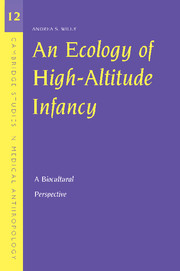Book contents
- Frontmatter
- Contents
- List of Figures, Photographs, and Tables
- Acknowledgments
- Abbreviations
- Glossary of Ladakhi Words
- An Ecology of High-Altitude Infancy
- 1 Introduction
- 2 Challenges of High-Altitude Living
- 3 Contextualizing Reproductive Health Research in Ladakh
- 4 Big Mountains, Small Babies
- 5 An Ecology of Infancy in Ladakh
- 6 Comparative Perspectives on Reproductive Health in Ladakh
- 7 Toward Relevant Research: Adaptation and Policy Perspectives on Maternal-Infant Health in Ladakh
- Notes
- References
- Index
- Titles in the series
3 - Contextualizing Reproductive Health Research in Ladakh
Published online by Cambridge University Press: 18 December 2009
- Frontmatter
- Contents
- List of Figures, Photographs, and Tables
- Acknowledgments
- Abbreviations
- Glossary of Ladakhi Words
- An Ecology of High-Altitude Infancy
- 1 Introduction
- 2 Challenges of High-Altitude Living
- 3 Contextualizing Reproductive Health Research in Ladakh
- 4 Big Mountains, Small Babies
- 5 An Ecology of Infancy in Ladakh
- 6 Comparative Perspectives on Reproductive Health in Ladakh
- 7 Toward Relevant Research: Adaptation and Policy Perspectives on Maternal-Infant Health in Ladakh
- Notes
- References
- Index
- Titles in the series
Summary
High in a remote mountainous desert of the western Himalaya, Ladakh is geopolitically part of India. It shares unstable, ambiguous, and contested borders with Pakistan and China, as shown in Figure 3.1. Popularly referred to as the “Snowland,” “Wonderland,” “Moonland,” “Little Tibet,” or “the last Shangri-la,” its remote location and barren landscape yet colorful and “exotic” culture and the quiet joie de vivre of Ladakhis have intrigued researchers and adventure travelers alike. Descriptions of Ladakh tend to emphasize its contrasts; it is a rare account that does not begin with a dual description of the area as both “otherworldly beautiful” and barren, harsh, and unforgiving.
The landscape provides more than a mere backdrop, as the unusual ecology of the trans-Himalayan plateau plays center stage in many analyses of Ladakhi society and culture. While this is appropriate in many ways, we risk concluding that Ladakhi life is entirely determined by the natural environment. Appadurai articulated this problem more generally within anthropology by noting that
there is a tendency for places to become showcases for specific issues over time…. [T]he discussion of the theoretical issues tends to surreptitiously take on a restrictive local cast, while on the other hand the study of other issues in the place in question is retarded, and thus the over-all nature of the anthropological interpretation of the particular society runs the risk of serious distortion…. A few simple theoretical handles become metonyms and surrogates for the society as a whole.
(1986:358)- Type
- Chapter
- Information
- An Ecology of High-Altitude InfancyA Biocultural Perspective, pp. 39 - 70Publisher: Cambridge University PressPrint publication year: 2004



